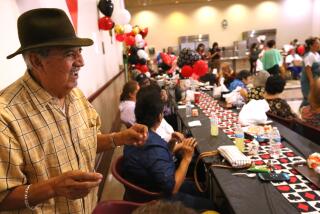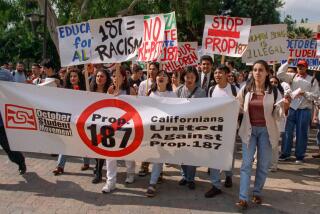Asian, Latino Population Has Surged, Survey Finds
Ventura County’s Latino and Asian populations have increased about 40% since 1990 while the number of local white residents dropped by 2.5%, according to a new U.S. Census Bureau survey.
The percentage of the white population dropped from 66% to 58% during the past decade, according to the estimate, and if that trend continues the county will have no racial or ethnic majority by 2010. The federal report found such a shift already occurring statewide, with nonwhites accounting for 50.1% of the population in 1999.
Ventura County planner Steve Wood, who specializes in demographic studies, said the estimated drop in the county’s white population from 440,574 in 1990 to 429,685 in 1999 was of particular interest because he believed the population had been growing among all racial groups.
“The surprise to me was not so much that there was a shift in percentages but that the actual numbers of whites have decreased,” he said. “It’s either that there’s been an out-migration of whites or whites are not producing.”
Jamshid Damooei, professor of economics at Cal Lutheran University in Thousand Oaks, attributed the reported loss in absolute population among whites to structural changes in the economy.
“I would say economic changes attracted them to other places,” he said.
The new census estimate being unveiled today is the last before the actual 2000 count is released in late December. It shows Ventura County’s population has increased 11.4% overall during the past nine years, to 745,063.
But that growth has been most striking among Asians, whose numbers increased 43.3% to 47,551, and Latinos, whose population jumped 39.5% to 248,754, since 1990, according to the survey.
The report indicates that Latinos now make up one-third of the county population, while Asians account for 6.4%. The next-largest ethnic group is African Americans, who make up 2.1% of the county population.
The county’s white population has reportedly dropped from 72.4% in 1980 to 57.7% today, while Latinos have grown from 21.4% to 33.4%.
“Welcome to California in the 21st century,” said Karl Lawson, who directed Oxnard’s census outreach this spring. “In family size and demographics, we are rapidly approaching the point where [whites] will be less than half of the population.”
Lawson, however, said he will defer drawing any conclusions until the actual census figures come out later this year. The estimates have too much potential for significant error, he said.
“It’s certainly interesting, but what’s the point of estimating a patient’s temperature just before you pull out the thermometer?” he asked.
Census counts are important because cities, counties and states receive federal dollars based on their populations and the wealth of residents.
The county’s increasing racial diversity does not necessarily mean Ventura County is becoming poorer, Damooei said. But he added that the demographic shift should cause policymakers to begin spending more money to provide increased educational opportunities to minorities, and Latinos in particular.
“We need to invest more in people, because you see identifiable needs there,” he said. “We’ve got to be honest about these issues and figure out how we can create more opportunities.”
The ethnic shift in the county can be attributed in part to the fact that since the mid-1990s, Latinos here have had more babies than whites. Over the past decade, Ventura County Latinos had children at twice the rate of local whites, according to state health reports.
Chuck Weis, Ventura County superintendent of schools, said this could explain why educators have seen the trend reflected in the census survey since the late 1980s. Today, Latinos make up more than 40% of school enrollments, and whites make up just less than 50%.
“In terms of ethnicity, you always see trends in children first,” Weis said. “Schools have already geared up for it because we’re already living the future.”
*
NEW MAJORITY?
State’s ethnic minorities may now be the majority. A1
(BEGIN TEXT OF INFOBOX / INFOGRAPHIC)
County Racial / Ethnic Profile, 1980-1999
The following compares the percentages of each group over two decades.
*--*
American Total White Latino Asian Black Indian population 1980 72.4 21.4 3.0 2.1 0.9 529,174 1990 65.9 26.6 5.0 2.2 0.5 669,016 1999 * 57.7 33.4 6.4 2.1 0.5 745,063
*--*
Racial / Ethnic Shift
*--*
American Total White Latino Asian Black Indian population 1990 440,574 178,266 33,192 14,672 3,428 669,016 1999 * 429,685 248,754 47,551 15.564 3,509 745,063 % change -2.5% +39.5% +43.3% +6.1% +2.4% +11.4%
*--*
* Based on Census Bureau survey estimates
Source: U. S. Census Bureau
More to Read
Sign up for Essential California
The most important California stories and recommendations in your inbox every morning.
You may occasionally receive promotional content from the Los Angeles Times.










